|

Reference Guide
|
|
How to
Using Automatic Roll Paper Cutter
 Cutting position adjustment with Automatic Roll Paper Cutter
Cutting position adjustment with Automatic Roll Paper Cutter
 Using Automatic Roll Paper Cutter
Using Automatic Roll Paper Cutter
Cutting position adjustment with Automatic Roll Paper Cutter
Make sure to adjust the cutting position to improve its precision. Follow the procedure described in the next section in order to adjust the cutting position of the cutter.
 |
Note:
|
 | -
Before adjusting the cutter position, it is necessary to turn the printer on and set the roll paper.
|
|
 | -
To maintain a precise cutting position, we recommended to adjust the cutting position each time you change the type or size (width) of roll paper.
|
|
For Windows users
 |
For Windows 2000, Me, and 98 users, click Start, point to Settings, then click Printers to open the Printer folder.
|
For Windows XP users, click Start, then click Control Panel, then click Printers and Other Hardware, then click Printers and Faxes to open the Printers and Faxes folder.
 |
For Windows Me and 98 users, select EPSON Stylus Photo 925 icon then click Properties on the File menu.
|
For Windows XP and 2000 users, select EPSON Stylus Photo 925 icon then click Printing Preferences on the File menu.
The printer software opens.
 |
Click Utility tab, then click Printer and Option Information. The Printer and Option Information dialog box opens.
|
 |
Click the Auto Cutter Adjustment button. The Cut Position Alignment dialog box opens.
|
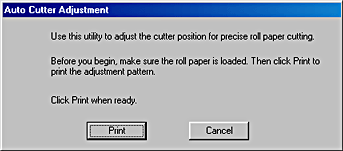
 |
After making sure that the roll paper is set, click the Print button. The cutting position adjustment pattern is printed and cut off.
|
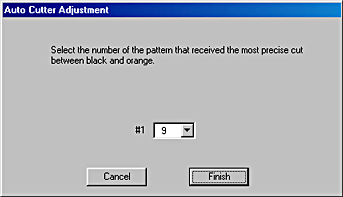
 |
By using the cut roll paper, check the most precisely printed number among the color boundaries.
|

 |
Select the number of the most precisely printed color boundary from the list box. Click Finish to enable the adjustment.
|
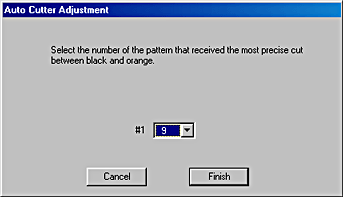
For Macintosh
 |
Click Print on the File menu of your application. The Print dialog box opens.
|
 |
Click the  Utility icon button. The Utility dialog box opens. Utility icon button. The Utility dialog box opens.
|
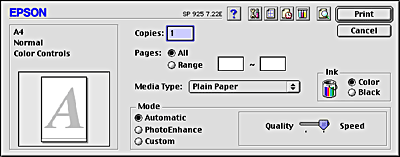
 |
Click Printer and Option Information. The Printer and Option Information dialog box opens.
|
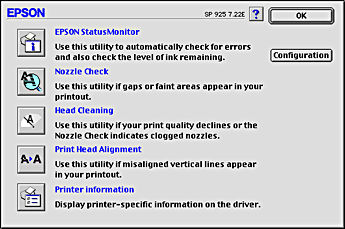
 |
Click the Auto Cutter Adjustment button. The Cut Position Alignment dialog box opens.
|
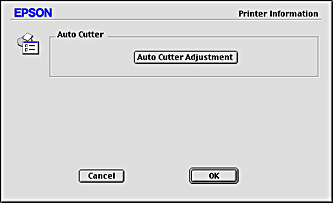
 |
After making sure that the roll paper is set, click the Print button. The cutting position adjustment pattern is printed and cut off.
|
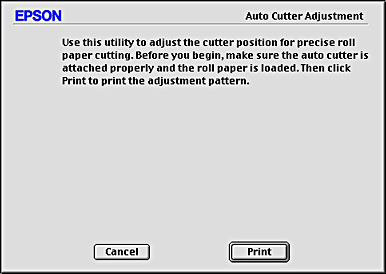
 |
By using the cut roll paper, check the most precisely printed number among the color boundaries.
|

 |
Select the number of the most precisely printed color boundary form the list box. Click Finish to enable the adjustment.
|
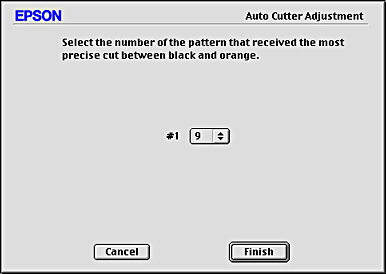
Using the control panel
 |
Press the  maintenance button to display the Advanced Settings menu. maintenance button to display the Advanced Settings menu.
|
 |
Press the  button to position the cursor at the Cutting Position Adjustment and press the Select button. button to position the cursor at the Cutting Position Adjustment and press the Select button.
|
 |
Check that the roll paper is set and press the Custom 1 button.
|
The cutting position adjustment pattern is printed out, and the roll paper is automatically cut.
 |
Look at the cutting position adjustment pattern and find the number for which the color boundary is cut with the highest precision.
|

 |
Press the  or or  buttons to position the cursor at the number identified in step 4, and press the Select button. buttons to position the cursor at the number identified in step 4, and press the Select button.
|

[Top]
Using Automatic Roll Paper Cutter
The following describes how to print on the roll paper using the cutter. The steps from the printer driver settings to cutting are as follows.
For Windows users
 |
Note:
|
 | -
When printing on roll paper, you cannot use the Reverse Order or Rotate by 180° features. You also cannot select Maximum or Centered as the Printable Area setting, or use the functions on the Layout menu.
|
|
 | -
Do not select PhotoEnhance in the printer software, as this may cause your printout to have gaps.
|
|
After the roll paper is loaded in the printer, follow the steps below to configure your printer software for printing.
 |
Open the file you want to print in the appropriate application.
|
 |
Access the printer software from within the application.
|
 |  |
Note:
|
 |  | |
For details on accessing the software, refer to the application's user manual. In many applications, you can select Print directly from the File menu, then access the printer software by clicking the Properties button.
|
|
 |
Click the Paper tab, select Roll Paper for Paper Source, and select the appropriate page size.
|
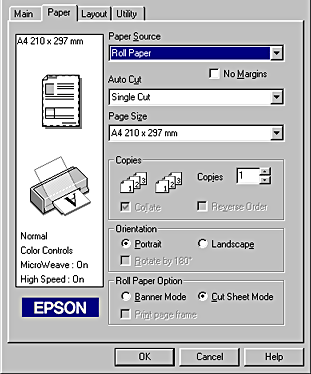
 |  |
Note:
|
 |  | |
Do not select Sheet Feeder as the Paper Source setting in the printer software when roll paper is loaded in the sheet feeder. Doing so causes unnecessary paper to be fed after each print job. If you have already started printing, cancel the print job from the printer software referring to Cancelling Printing. Wait until the printer stops printing and feeding paper. Cut off the paper at the back of the printer, then turn off the printer. The remaining paper is ejected.
|
|
 |
Select the types of cutting from Auto Cut list box.
|
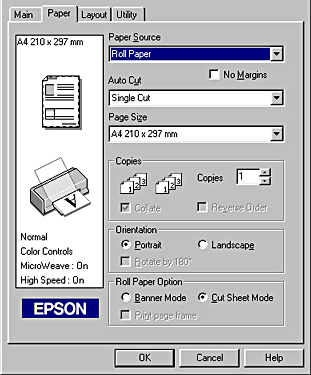
The Auto Cut settings are as follows:
|
Not Cut
|
No cutting with the cutter is done. Press the roll paper button in order to cut the roll paper.
|
|
Single Cut
|
The paper is cut at the boundary between images (the boundary between pages). However, the cutting position may shift slightly.
|
|
Double Cut
|
If you have selected Single Cut and are unhappy with the gap of the cutting position, select Double Cut. In this mode, the space between images is extended and the paper is cut twice inside this space. By cutting twice, an 18 mm slip of paper is left. Double Cut is selectable only when printing with No Margins selected.
|
 |  |
Note:
|
 |  | -
Auto Cut is selectable after Roll Paper is selected as the Paper Source setting.
|
|
 |
Make the Roll Paper Option settings at the bottom of the dialog box.
|

The Roll Paper Option settings are as follows:
|
Banner Mode
|
Select this mode when you want to print multi-page data as continuous data on the roll paper, rather than as individual pages. When this check box is selected, the Save Roll Paper check box is enabled.
|
|
Cut Sheet Mode
|
Select this mode when you want to print multi-page data as individual pages, rather than as continuous data. When this check box is selected, the Print page frame check box is enabled.
|
|
Save roll paper
|
Select this check box when you do not want any paper to be fed after the data is printed. This feature is only available when Not Cut and Banner Mode is selected.
|
|
Print page frame
|
Select this check box to print a line on the roll paper between pages in a multi-page document to indicate where the paper should be cut. This feature is useful when it is unclear where the page breaks should be or where the paper should be cut after the last page has been printed. This feature is only available when Not Cut and Cut Sheet Mode is selected.
|
 |
Go to the Main menu and select the media type.
|
 |
Click OK to close the printer software and print your document.
|
 |
When print job is executed, wait until the printer prints out the last page and stops its operation.
|
When you print two or more pages, each printout is automatically cut except the last page.
When you print only one page, the printout remains without being cut.
When Not Cut is selected in the Auto Cut list box, the paper is ejected without being cut.
 |  |
Note:
|
 |  | |
When Double Cut is selected in the Auto Cut list box, the printer prints the paper with some margin between the printouts. In order to cut the printouts front and back, gaps of 18 mm are left.
|
|
 |
Press the  roll paper button in order to cut the last page. roll paper button in order to cut the last page.
|
When Not Cut is selected in the Auto Cut list box, the paper is cut with white borders at the edge of the print images.
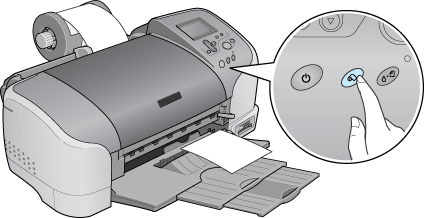
After your printouts are cut, the printer loads the roll paper back to the print position and the next job in the print queue (if any) is printed.
For Macintosh users
 |
Note:
|
 | -
The procedures described in this section may vary, depending upon the application you are using. Check your application's user manual for details.
|
|
 | -
When printing on roll paper, you cannot use the Reverse Order or Rotate by 180° features, select Maximum or Centered as the Printable Area setting, or use the functions in the Layout dialog box.
|
|
 | -
Do not select PhotoEnhance in the printer software, because it may cause your printout to have gaps.
|
|
After the roll paper is loaded in the printer, make sure that the Stylus Photo 925 is selected in the Chooser before proceeding. Follow the steps below to configure your printer software for printing.
 |
Open the file that you want to print in the appropriate application.
|
 |
Open the printer software.
|
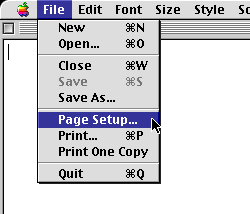
 |  |
Note:
|
 |  | |
In most applications, you can do this by selecting Page Setup (or Print Setup) on the File menu.
|
|
 |
Select Roll Paper for Paper Source and make the appropriate Paper Size setting. You can select either a predefined paper size or create a custom paper size.
|
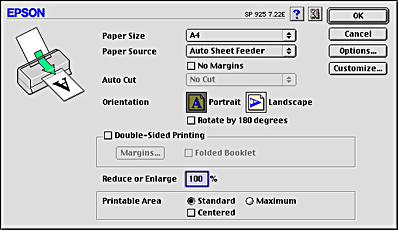
 |  |
Note:
|
 |  | |
Do not select Sheet Feeder as the Paper Source setting in the printer software when roll paper is loaded in the sheet feeder. Doing so causes unnecessary paper to be fed after each print job. If you have already started printing, cancel the print job from the printer software referring to Cancelling Printing. Wait until the printer stops printing and feeding paper. Cut off the paper at the back of the printer, then turn off the printer. The remaining paper is ejected.
|
|
 |
Select the types of cutting from Auto Cut list box.
|
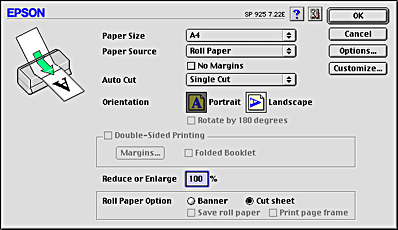
The Auto Cut settings are as follows:
|
Not Cut
|
No cutting with the cutter is done. Press the roll paper button in order to cut the roll paper.
|
|
Single Cut
|
The paper is cut at the boundary between images (the boundary between pages). However, the cutting position may shift slightly.
|
|
Double Cut
|
If you have selected Single Cut and are unhappy with the gap of the cutting position, select Double Cut. In this mode, the space between images is extended and the paper is cut twice inside this space. By cutting twice, an 18 mm slip of paper is left. Double Cut is selectable only when printing with No Margins selected.
|
 |  |
Note:
|
 |  | -
Auto Cut is selectable after the cutter is attached and Roll Paper is selected as the Paper Source setting.
|
|
 |
Make any other settings as necessary. Refer to the table below for details. When finished, click OK.
|
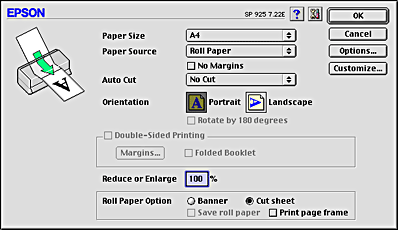
The Roll Paper Option settings are as follows:
|
Banner Mode
|
Select this mode when you want to print multi-page data as a continuous printout on roll paper, rather than as individual pages. When this check box is selected, the Save roll paper check box is enabled.
|
|
Cut Sheet Mode
|
Select this mode when you want to print multi-page data as individual pages, rather than as continuous data. When this check box is selected, the Print page frame check box is enabled.
|
|
Save roll paper
|
Select this check box when you do not want any paper to be fed after the data is printed. This feature is only available when Not Cut and Banner Mode is selected.
|
|
Print page frame
|
Select this check box to print a line on the roll paper between pages in a multi-page document to indicate where the paper should be cut. This feature is useful when it is unclear where the page breaks should be or where the paper should be cut after the last page has been printed. This feature is only available when Not Cut and Cut Sheet Mode is selected.
|
 |
Select Print on the File menu to open the Print dialog box.
|
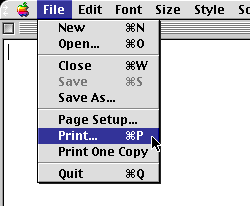
 |
Make the appropriate Media Type setting, then click the Print button to print your document.
|
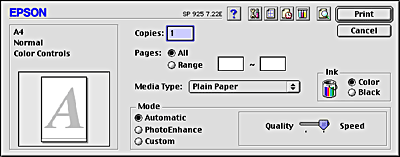
 |  |
Note:
|
 |  |
Click the  Preview icon button to change the Print button to a Preview button. Click the Preview button to see a preview of the printout. Preview icon button to change the Print button to a Preview button. Click the Preview button to see a preview of the printout.
|
|
 |
When print job is executed, wait until the printer prints out the last page and stops its operation.
|
When you print two or more pages, each printout is automatically cut except the last page.
When you print only one page, the printout remains without being cut.
When Not Cut is selected in the Auto Cut list box, the paper is ejected without being cut.
 |  |
Note:
|
 |  | |
When Double Cut is selected in the Auto Cut list box, the printer prints the paper with some margin between the printouts. In order to cut the printouts front and back, gaps of approximately 18 mm are left.
|
|
 |
Press the  roll paper button in order to cut the last page. roll paper button in order to cut the last page.
|
When Not Cut is selected in the Auto Cut list box, the paper is cut with white borders at the edge of the print images.

After your printouts are cut, the printer loads the roll paper back to the print position and the next job in the print queue (if any) is printed.

[Top]
| Version 1.00E, Copyright © 2002, SEIKO EPSON CORPORATION |
Cutting position adjustment with Automatic Roll Paper Cutter
Using Automatic Roll Paper Cutter